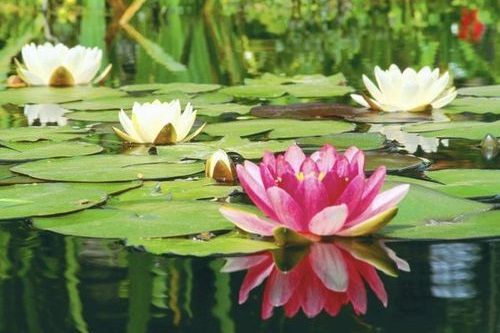4 Major Groups of Aquatic Plants
Aquatic Plants are plants that grow in water. Such plants occur in almost every major group of the plant kingdom and are widely distributed throughout the world, inhabiting oceans and brackish lakes as well as freshwater lakes, rivers, and streams. Although most aquatic plants live only in water, some species may also live on land. In these species, however, the land-dwelling form often differs in appearance from the aquatic form. The aquatic arrowhead, for example, has limp, ribbonlike leaves, while the terrestrial form bears the stiff, arrowhead-shaped leaves from which the plant's name is derived.

Major Groups
Aquatic plants are generally divided into four major groups. Plants of the first group float freely on or below the surface of the water and have no connection with the soil. Among the best known of these plants is the salvinia, a small ornamental plant with whorls of oval leaves that are covered with stiff, bristly hairs on their upper surface. The salvinia is grown in home aquariums as well as in outdoor ponds.
The second group of aquatic plants is made up of plants whose leaves float on the water's surface but whose roots are anchored in the soil at the bottom. Among these leaf-floating plants are many popular ornamental species, including the white lotus and the royal water lily.
The third major group is composed of plants that live submerged in water, with their roots in the soil, but with their flower stalks rising above the water's surface. Included in this group is the riverweed.
In the fourth major group of water plants are those whose leaves, stems, and flowers grow above the water with their roots anchored in the soil. This group is the largest and contains the arrowhead, cattail, pickerel weed, and many other familiar plants.

Major Groups
Aquatic plants are generally divided into four major groups. Plants of the first group float freely on or below the surface of the water and have no connection with the soil. Among the best known of these plants is the salvinia, a small ornamental plant with whorls of oval leaves that are covered with stiff, bristly hairs on their upper surface. The salvinia is grown in home aquariums as well as in outdoor ponds.
The second group of aquatic plants is made up of plants whose leaves float on the water's surface but whose roots are anchored in the soil at the bottom. Among these leaf-floating plants are many popular ornamental species, including the white lotus and the royal water lily.
The third major group is composed of plants that live submerged in water, with their roots in the soil, but with their flower stalks rising above the water's surface. Included in this group is the riverweed.
In the fourth major group of water plants are those whose leaves, stems, and flowers grow above the water with their roots anchored in the soil. This group is the largest and contains the arrowhead, cattail, pickerel weed, and many other familiar plants.

Comments
Post a Comment